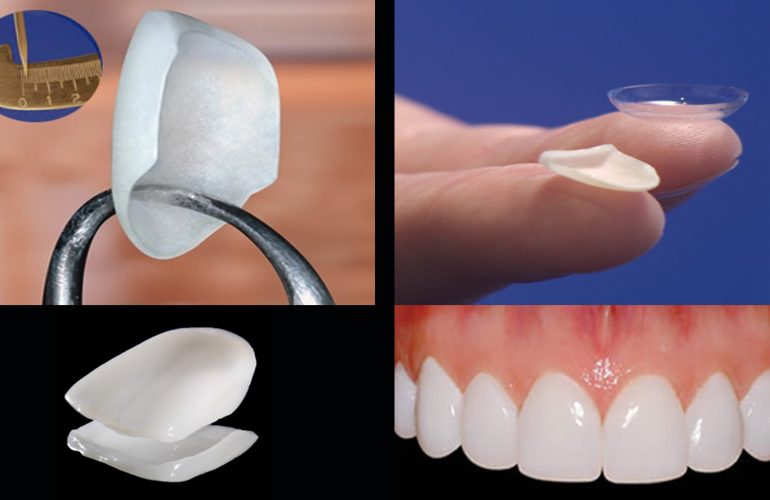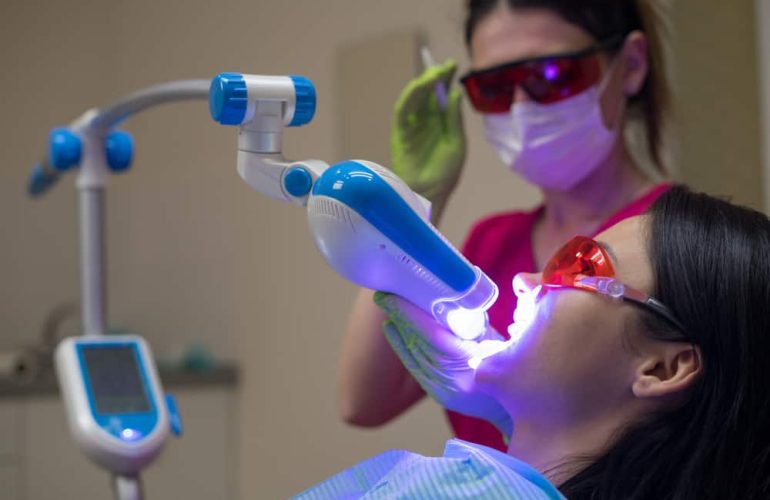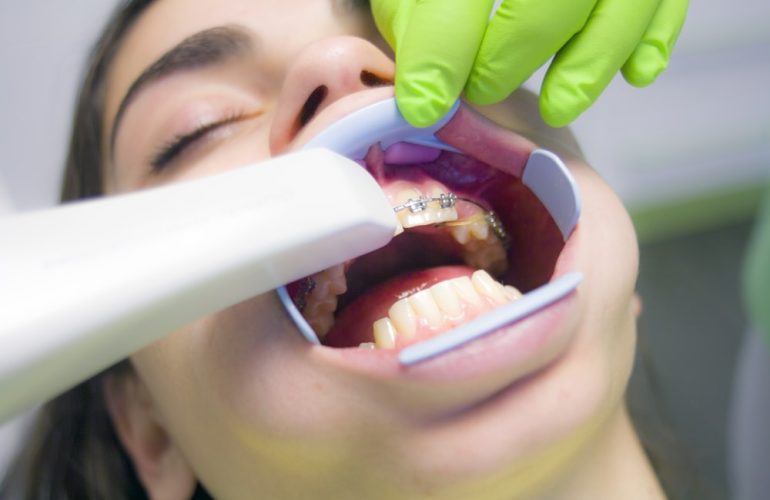The root canal treatment procedure, also known as endodontic treatment, is a common procedure in modern dentistry that is used to remove inflamed or infected tissue from inside a tooth. Beneath the enamel and dentin layer of teeth, a type of soft tissue referred to as pulp is found inside each tooth.
The root canal treatment procedure, also known as endodontic treatment, is a common procedure in modern dentistry that is used to remove inflamed or infected tissue from inside a tooth.
Beneath the enamel and dentin layer of teeth, a type of soft tissue referred to as pulp is found inside each tooth. The pulp contains blood vessels, nerves and connective tissue. This pulp is essential for the growth and development of a tooth, although it is possible for a fully developed tooth to exist without it
because it can obtain nourishment from the surrounding tissues.
A root canal procedure involves the removal of pulp that is infected or inflamed. The pulp chamber and root canal are completely cleaned out and refilled to protect the area from further damage.
Indications for Root Canal Treatment
The root canal treatment procedure is a good solution with many potential benefits for patients who have significant inflammation or infection in the pulp of a tooth. Without treatment, the infection may progress to cause significant pain or cause the formation of an abscess underneath the tooth, which affects the strength and function of the tooth.
Root canal treatment can help to maintain the function of the teeth so that patients may continue to chew effectively using normal biting force. It also helps to maintain the natural aesthetic appearance of the tooth, in contrast to alternative options, such as dental Implants. Additionally, root canal treatment can help to protect other teeth in the mouth from excessive strain and possible damage, as may occur if only one side of the mouth is used.
Step-by-Step Root Canal Procedure
The first step in the root canal treatment is making an examination of the tooth so that the dentist
understands the nature of the problem and is able to treat it effectively. This typically involves a physical
examination of the inside of the mouth, in addition to X-ray maging of the tooth to visualize the pulp
chamber.
Next, a local anesthetic is administered to numb the tooth and increase the comfort of the patient
during the procedure. A “dental dam” – a small protective sheet – is then put in place over the affected
area to isolate the tooth and keep saliva and other substances away from it while the work is
completed.
The dentist is then able to drill into the crown of the tooth to open it. This allows specialized dental
instruments to be inserted into the pulp chamber and root canals to clean the inflammed or infected
pulp from the area. The remaining space is then cleaned completely and shaped to make space for a
filling, which will replace the pulp in the tooth.
The root canal can then be filled with a suitable biocompatible material, such as gutta-percha. Adhesive
dental cement is also usually used to ensure that the root canal is properly sealed and to prevent future
infections in the area.
Once the root canal has been filled, a temporary filling is usually put in place over the opening to seal it.
Eventually, a crown is usually placed over the tooth to protect it over the long-term, but there is usually
a waiting period between dental appointments while the crown is constructed. A temporary filling is
useful during this time. At the subsequent dental appointment, the temporary filling can be removed
and the tooth restored with a crown or other restoration.
Pain During the Procedure
The techniques used to perform a root canal have progressed significantly over recent decades. As a
result, most patients now find that they are relatively comfortable while the procedure is being carried
out and do not experience significant pain.
This is in large part due to the local anesthesia used during the procedure to numb the area. It may, in
fact, bring relief to the patient, particularly if the pulp inflammation caused significant pain and thus
brought about the need for a root canal treatment.
Root canal symptoms
The only way to know for sure if you need a root canal is by paying a visit to
your dentist. But there are several warning signs to be on the lookout for.
If you notice any of these symptoms, it’s important to see your dentist as soon
as possible. The sooner your tooth can be treated, the better the outcome will
likely be.
1. Persistent pain
Persistent tooth pain is one of the signs that you may need a root canal. The
pain in your tooth might bother you all the time, or it might go away from time
to time but always return.
You may feel the pain deep in the bone of your tooth. Or you may feel referred
pain in your face, jaw, or in your other teeth.
Tooth pain may have other causes besides root canal. Some other
possibilities include:
- gum disease
- a cavity
- referred pain from a sinus infection or another problem
- a damaged filling
- an impacted tooth that may be infected
2. Sensitivity to heat and cold
Does your tooth hurt when you eat warm food or when you drink a cup of coffee? Or
perhaps your tooth feels sensitive when you eat ice cream or drink an icy-cold glass of
water.
The sensitivity could feel like a dull ache or a sharp pain. You may need a root canal
if this pain lingers for an extended period of time, even when you stop eating or
drinking.
If your tooth hurts when you eat or drink something hot or cold, it may be an
indication that the blood vessels and nerves in your tooth are infected or damaged.
3. Tooth discoloration
An infection in the pulp of your tooth can cause your tooth to become discolored.
Trauma to the tooth or the breakdown of the internal tissue can damage the roots and
give the tooth a grayish-black appearance.
According to Kenneth Rothschild, DDS, FAGD, PLLC, who has 40 years of
experience as a general dentist, this discoloration is easier to see in a front (anterior)
tooth.
“Tooth pulps can die when there’s an inadequate blood supply, thus signaling a
possible need for a root canal,” Rothschild explained.
Although tooth discoloration can have other causes, it’s always a good idea to see
your dentist if you notice that a tooth is changing color.
4. Swollen gums
Swollen gums near the painful tooth can be a sign of an issue that requires a root
canal. The swelling may come and go. It may be tender when you touch it, or it may
not be painful to the touch.
“Swelling is caused by acidic waste products of dead pulp tissues, which may lead to
swelling (edema) outside the root tip area,” explained Rothschild.
You may also have a little pimple on your gum. This is called a gum boil, parulis, or
abscess.
The pimple may ooze pus from the infection in the tooth. This can give you an
unpleasant taste in your mouth and make your breath smell bad.
5. Pain when you eat or touch the tooth
If your tooth is sensitive when you touch it or when you eat, it could indicate severe
tooth decay or nerve damage, which may need to be treated with a root canal. This is
especially the case if the sensitivity persists over time and doesn’t go away when you
stop eating.
“The ligament around the root tip of an infected tooth may become hypersensitive
from the pulp dying. The waste products from the dying pulp may irritate the
ligament, causing pain from biting pressure,” said Rothschild.
6. A chipped or cracked tooth
If you’ve chipped or cracked your tooth in an accident, in a contact sport, or by
chewing on something hard, bacteria can set in and lead to inflammation and
infection.
Even if you injure a tooth, but it doesn’t chip or crack, the injury may still damage the
nerves of the tooth. The nerve can become inflamed and cause pain and sensitivity,
which may require root canal treatment.
7. Tooth mobility
When your tooth is infected, it may feel looser.
“This can be caused by other factors besides pulpal necrosis (nerve death), but it can
be a sign that a root canal is necessary,” said Rothschild. “Acidic waste products from
nerve death can soften the bone around the root of a dying tooth, causing mobility.”
If more than one tooth feels loose, the mobility is likely to have a cause other than an
issue that may need a root canal.
Does a root canal hurt?
A root canal procedure sounds scary, but with today’s technology, it’s typically not a
whole lot more different than having a deep filling. There’s little to no pain because
your dentist will use local anesthesia to numb your tooth and gums so you’re
comfortable during the procedure.
If you need a root canal and have facial swelling or a fever, your dentist may give you
antibiotics beforehand to kill the infection. This may also help reduce your pain.
The root canal procedure itself is similar to getting a large filling, but it’ll take longer.
Your mouth will be numbed while the dentist cleans out the decay, disinfects the
roots, and then fills them in.
Your dentist will use a rubber dam around the root canal tooth. This will help prevent
any infected material from spreading to the rest of your mouth.
Your mouth may feel sore or tender after the root canal. Your dentist may suggest that
you take an over-the-counter pain medication such as acetaminophen (Tylenol) or
ibuprofen (Advil).
A 2011 review of 72 studies of root canal patients looked at pre-treatment, treatment,
and post-treatment pain.
The analysis found that pre-treatment pain was high, but dropped moderately within a
day of treatment, and then dropped substantially to minimal levels within a week.
How to prevent a root canal
To prevent a root canal, it’s important to follow the same dental hygiene habits that
help prevent cavities and other tooth problems. To keep your teeth healthy, try to get
into the habit of following these steps:
- Brush your teeth at least twice a day.
- Use fluoride toothpaste or a fluoride rinse.
- See your dentist for checkups every 6 months.
- Have your teeth professionally cleaned by your dentist at least once a year.
- Try to limit the amount of sugary food and refined carbohydrates you eat.
These foods have a tendency to stick to your teeth. If you eat sugary foods, try
to rinse your mouth or brush your teeth shortly afterward.
Can you still get pain in a tooth that’s had a root canal?
Yes, it’s possible to have pain in a tooth that’s had a prior root canal.
Some causes of this pain may be due to:
- your root canal not healing properly
- your root canal not being completely disinfected because of complicated
root anatomy - new decay can infect the root canal filling material, causing a new
infection - a tooth injury that allows new decay to enter the tooth
Our dentist

Dr. Manju Prasad M

Dr. Pallavi





